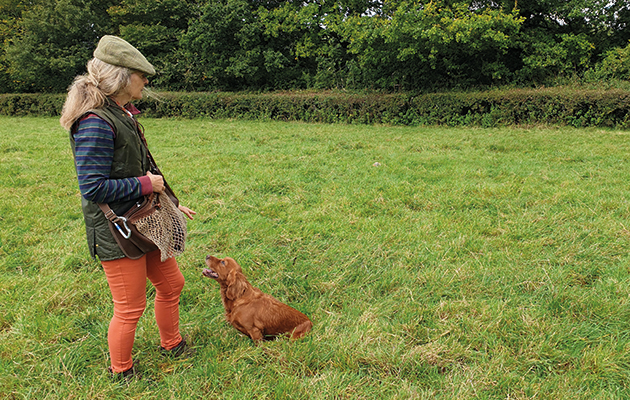All you need to handle a gundog are a slip lead and whistle; the secret lies in knowing exactly when and how to use them, says David Tomlinson
I was recently asked what is essential gundog handling kit. I thought about the question for 30 seconds before replying: a slip lead and a whistle. I’ve now given the question more consideration, but my opinion remains unchanged. If you have these two vital pieces of equipment, then there’s not much more you really need. (Read more on gundog whistles here.)
Essential gundog handling kit
You can always spot pet gundogs, as they are generally exercised on collars and leads, or these days more likely a harness with a retractable lead. Harnesses have become highly fashionable, but I would never recommend one unless you want your dog to tow a sledge, as they encourage a dog to pull. Rope slip leads have the great advantage in that they are easy to take on and off, and though they may not stop a determined dog from pulling, they are perfect for handling your dog in the shooting field. (Read our full list of gundog training tips here.)
Slip leads
Even if your dog walks beautifully to heel, never hesitate to use a slip lead, especially on a shoot day when there are all sorts of dangers and distractions lurking. A professional dog trainer once suggested to me that a slip lead should be regarded in the same way as a tightrope walker’s safety net. You hope that it’s not needed, but it can prove to be a lifesaver.
Avoid the cheap and nasty nylon slip leads; the most satisfactory ones are those made from top-quality marine rope. It’s not only strong and durable, but it’s also pleasant to handle, while it’s also washable. Put your dirty leads in the washing machine after a day’s shooting and they come out looking like new. There was a time when I favoured the chunky 12mm diameter leads, but they do look out of proportion on a spaniel and are probably best suited to leading your prize bull. I now favour 8mm, which is the most popular size. You can go down to 4mm, but 6mm is the best compromise if you like a thin lead.
Getting the length right is vital: the usual options are 0.9m (too short), 1.5m (sensible length) and 1.8m (slightly too long). A sliding stopper is useful as this ensures that the lead doesn’t either slip over the dog’s head or end up around its stomach. Colour is also important. I used to favour environmentally friendly tan or dark green, but if you drop one it’s likely to be lost forever. I now opt for bright colours, with my current favourite chrome yellow. Devon-based KJK is one of the top manufacturers of rope leads in this country and offers a great variety of lengths and colours.
What about whistles?
With whistles the common error is to buy the loudest available. Dogs have very sensitive ears and can hear sounds that are inaudible to us, so a loud whistle is unnecessary. With my first spaniel I used an Acme silent whistle, but eventually abandoned it because the dog ignored it and I couldn’t hear it, which was highly frustrating. I now use what has become the standard dog whistle, an Acme No 2101/2. (The number indicates the pitch: you can also buy a 210 or a 2111/2, but not a 211.) Like the Ford Model T, all Acme whistles used to be black, but Acme now sells them in a great variety of cheerful colours, from baby blue to lime green, while the cost is around a tenner. The secret of good handling is not to use the whistle except when you need it. The noisier the handler, the less likely the dog is to respond. The best handlers are sparing in their use of the whistle.
If you research gundog handling kit online, you will come up with a bewildering variety of options, much of which you can happily live without. Today training dummies come in a huge variety of shapes and sizes, though many trainers still depend on the old and reliable canvas dummies stuffed with sawdust. The latest dummies are designed and made to look like gamebirds, complete with wings and tail. As a preparation for the real thing, they are about as good as it gets, so are worth investing in. (Read the 10 commandments of gundog training.)
What I would avoid at all costs is the classic dummy launcher, propelled by a .22 blank. I’ve known confident dogs become gun-shy from being trained with these nasty devices, which require the trainer to use ear defenders. Recoil can also be a problem. I wouldn’t bother, either, with a starting pistol for familiarising a puppy with the sound of a gunshot. Much kinder and cheaper alternatives include old-fashioned cap guns or even party poppers. They produce subtle bangs that are unlikely to frighten even the most nervous puppy. (Read

Bright slip leads and whistle – all the essential kit
Another piece of kit, now highly fashionable among triallers, is the training vest, a gilet that features a capacious pocket on the back with room for your sandwiches. Almost every handler at last year’s Retriever Championship was wearing one, and they are now the essential uniform of the serious gundog trialler. They look awful. Much better, in my opinion, to spend the money on a coat for your dog, to slip on when the action is over. (Read David’s piece on gundog coats here.)





